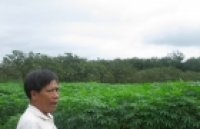| Fine mapping of the qLOP2 and qPSR2 1 loci associated with chilling stress tolerance of wild rice seedlings |
|
Using leaf osmotic potential and plant survival rate as chilling‑tolerant trait indices, we iden‑ tified two major quantitative trait loci qLOP2 and qPSR2‑1 (39.3‑kb region) and Os02g0677300 as the cold‑inducible gene for these loci |
|
Ning Xiao · Wei‑nan Huang · Ai‑hong Li · Yong Gao · Yu‑hong Li · Cun‑hong Pan · Hongjuan Ji · Xiao‑xiang Zhang · Yi Dai · Zheng‑yuan Dai · Jian‑min Chen
Theor Appl Genet (Januaray 2015) 128:173–185 http://link.springer.com/journal/122
Key message
Using leaf osmotic potential and plant survival rate as chilling‑tolerant trait indices, we iden‑ tified two major quantitative trait loci qLOP2 and qPSR2‑1 (39.3‑kb region) and Os02g0677300 as the cold‑inducible gene for these loci.
Abstract
Chilling stress tolerance (CST) at the seedling stage is an important trait affecting rice production in temperate climate and high-altitude areas. To identify quan titative trait loci (QTLs) associated with CST, a mapping population consisting of 151 BC2F1 plants was constructed by using chilling-tolerant Dongxiang wild rice (Oryza rufipogon Griff.) as a donor parent and chilling-sensitive indica as a recurrent parent. With leaf osmotic potential (LOP) and plant survival rate (PSR) as chilling-toleranttrait indexes, two major QTLs, qLOP2 (LOD = 3.8) and qPSR2-1 (LOD = 3.3), were detected on the long arm of chromosome 2 by composite interval mapping method in QTL Cartographer software, which explained 10.1 and 12.3 % of the phenotypic variation, respectively. In R/QTL analyzed result, their major effects were also confirmed. Using molecular marker RM318 and RM106, qLOP2 and qPSR2-1 have been introgressed into chilling-sensitive varieties (93-11 and Yuefeng) by marker-assisted selec- tion procedure (MAS), which resulted in 16 BC5F3 BILs that chilling tolerance have significantly enhanced compare with wild-type parents (P < 0.01). Therefore, two large segregating populations of 11,326 BC4F2 and 8,642 BC4F3 were developed to fine mapping of qLOP2 and qPSR2-1. Lastly, they were dissected to a 39.3-kb candidate region between marker RM221 and RS8. Expression and sequence analysis results indicated that Os02g0677300 was a cold- inducible gene for these loci. Our study provides novel alleles for improving rice CST by MAS and contributes to the understanding of its molecular mechanisms.
|
|
|
|
[ Tin tức liên quan ]___________________________________________________
|


 Curently online :
Curently online :
 Total visitors :
Total visitors :
(25).png)


